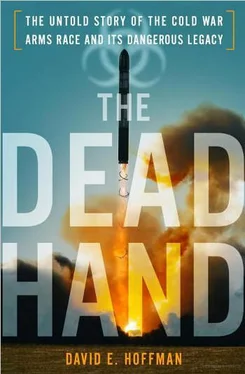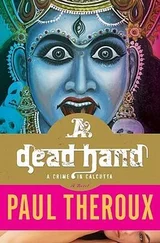Once, Domaradsky bitterly fought with his bosses when they suggested changing the outward appearance of the germ by attaching another organism, staphylococcus, to the tularemia bacteria. “This amounted to trying to stick a piece of the staphylococcus germ directly onto the surface of the tularemia cells, which could not possibly have worked,” he recalled. The creation would never replicate. “It’s a little like sticking the wings of a crow onto a cat and hoping the cat will produce flying kittens,” Domaradsky scolded.
Domaradsky had been appointed scientific director of Obolensk in 1978. Four years later, a new general director was appointed, Major General Nikolai Urakov, who had come from a military laboratory in Kirov. Urakov was tall, his hair always combed in a swoop back from his forehead, a man of military style and bearing. He loved expressions such as “master the situation!” and “burn with a white-hot iron!,” which meant to utterly destroy something.
While Domaradsky treasured his independence, and was eager to follow his curiosity into different subjects, Urakov tried to force progress on the tularemia project, and refused to let Domaradsky work on other pathogens. He made Domaradsky’s life miserable, sometimes calling meetings about tularemia on Saturday so the scientist could not visit his family in Moscow. “Being a soldier to the marrow of his bones, Urakov respected only force and brooked no arguments,” Domaradsky complained years later in his memoir. “For me and my colleagues, however, the most difficult aspect of Urakov’s regime was the complete neglect of fundamental science. Everyone who has ever dealt with the genetics of bacteria knows how complicated it is to produce a new strain, indeed to create a new species! In order to make Urakov realize this, we reported to him every detail of our work: how we obtained different variants, and the methods we used.” But Domaradsky said the director would not listen.
“I don’t need your strains! I need just one strain!” Urakov declared. “We are not playing here, we are making a weapon!”
In the laboratory, Domaradsky faced a huge obstacle: if a bacterium acquired some new characteristic, it could lose others. This happened to tularemia. “Having become resistant to several antibiotics, the strain lost its virulence, which was unacceptable to the military,” he said. If the virulence fell, or if a test animal managed to survive a day longer, the military regarded it as a serious setback. “The desired bioweapons strain had to be fully virulent and deliverable in aerosol form. One germ cell had to be enough to start a lethal infection in a monkey,” Domaradsky said. “Furthermore, the infection had to be incurable.”
Domaradsky came up with a fresh approach. He suggested taking two strains, both of which had lost virulence because of genetic engineering, but both having gained resistance to different antibiotics, and combining them into one super-germ. The pair, working together, might compensate for what each had lost in the genetic engineering. Domaradsky called this the “binary” approach, and had high hopes for it. The result might be “a rapidly growing, extremely virulent, and essentially untreatable disease, which would bring about the same result as if we had managed to produce a single super strain with its virulence and other properties intact.” He estimated the pair might be resistant to six or eight antibiotics at once. “This would make countering a biological weapons attack all but impossible,” he said, “especially on a large scale.”
But Urakov stubbornly rejected his plan.
As a young man, Domaradsky experienced the hardships and horrors of the early decades of the Soviet Union. Born in Moscow in 1925, he grew up in Saratov, along the Volga River, where his father had been sent after arrest and imprisonment during Stalin’s Great Terror. A grandfather was also arrested. Domaradsky never forgot the persecution of his relatives, the cruelty and violence of the system and the hunger of those early years. In late 1942, Domaradsky’s family fled to safety in Kazakhstan. In 1943, at seventeen years old, Domaradsky was summoned by the military for duty, but he was rejected because of the polio limp. He decided to study medicine and returned to Saratov after the war. By 1950, he had graduated from university and was assigned a research job at the All Union Anti-Plague Institute in Saratov, known informally as Mikrob.
Plague, the Black Death of the Middle Ages, has long been feared in Russia, and epidemics swept southern parts of the country in the nineteenth and early twentieth centuries. As a result, the Soviet Union established a network of specialized institutes to prevent and control plague outbreaks, and the Mikrob institute became the nerve center for the whole country, organizing investigations of the steppes and the deserts. Rodents such as marmots, gerbils and prairie dogs carried plague and it sometimes flared into epizootic outbreaks, an epidemic among animals that could spill over into human populations. The agent, Yersinia pestis , is transmitted from sick rodents to humans through fleas. In the field, Soviet plague-control researchers had to be microbiologists, epidemiologists, zoologists, parasitologists and sometimes general practitioners.
The biochemistry of the plague microbe had not been studied in the Soviet Union. For his doctorate, Domaradsky decided to examine the organism’s protein metabolism. He successfully defended his doctorate in 1956. Within a year, at thirty-one years old, he was appointed director of the anti-plague institute at Irkutsk in Siberia, which handled plague control and research for the entire Far East. In 1964, he was transferred to the anti-plague institute in Rostov-on-Don. It was a time of turmoil. The focus of the institute was being shifted from routine work on plague control to devising new ways to defend against biological weapons. This was Domaradsky’s first, tentative step into the world of germ warfare. The search for defenses against biological attack was known as “Problem No. 5.” 14
In the Cold War years of the 1950s and 1960s, both superpowers built arsenals of biological weapons from existing, known pathogens. Domaradsky viewed his work as a contribution to civil defense, a prudent measure to protect the population in the event of attack, just as underground bunkers would protect citizens from nuclear bomb fallout. The move to Rostov gave Domaradsky a rich opportunity to research the plague microbe just at the moment when microbiology was resurfacing in the Soviet Union.
Genetics expanded rapidly in the West with the discovery of the structure of DNA by James Watson, Francis Crick and Maurice Wilkins in 1953. In the decades that followed, scientists found ways to manipulate DNA in the laboratory. But in the Soviet Union, this was known only to a few Soviet scientists through smuggled journals and reports.
The field was paralyzed for a generation, starting in the 1930s, because of the influence of Trofim Lysenko, an agronomist who claimed that the acquired characteristics of plants and animals could be altered by tailoring their environment, and then passed from one generation to the next. Lysenko denied the fundamentals of genetics. He became a member of the Academy of Sciences, and his critics were persecuted and sent to the prison camps, including the great botanist and geneticist Nikolai Vavilov. By the 1950s, genetics disappeared as a discipline in the Soviet Union. Lysenko’s downfall came only a year after the ouster of Nikita Khrushchev as Soviet leader in October 1964. 15
Lysenko had left few scientists untouched. Domaradsky recalled that he had to insert some “rubbish” into his own doctorate dissertation to conform with Lysenko. But with Lysenko’s influence fading in the early 1960s, Domaradsky could push more deeply into the genetics of plague. At the Rostov laboratories, Domaradsky and his researchers made a major advance in understanding the nature of plasmids, strands of genetic material found in bacteria that carry the codes for such things as virulence and antibiotic resistance. Plasmids are used in genetic engineering because they can replicate without harming the organisms they come from and can be transferred into another bacterium, even of a different bacterial species. Domaradsky considered one of his triumphs the development of an antibiotic-resistant strain of plague that could be used for vaccines. It was developed for civil defense, he told himself; the Rostov institute had never been working directly on weapons. “On the other hand, there was a dark side to that research,” Domaradsky later acknowledged, “though I did not realize it at the time.” The dark side was that his discovery could just as easily be applied to Yersinia pestis to create a new, killer plague.
Читать дальше












